#nobel prize 2017
Text
"But in the end, stories are about one person saying to another: This is the way it feels to me. Can you understand what I'm saying? Does it feel this way to you?"
– Kazuo Ishiguro, in his Nobel prize (2017) acceptance speech.
#dark academia#light academia#excerpts#fragments#poetry#books & libraries#romanticism#dark academism#dark academia aesthetic#spilled ink#spilled thoughts#spilled words#spilled poem#quotations#words#books and reading#writings on tumblr#poets and writers#spilled writing#writers and poets
2K notes
·
View notes
Text

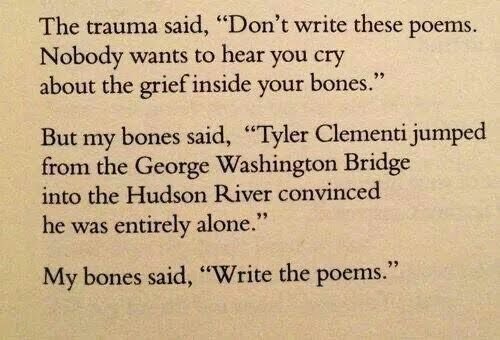



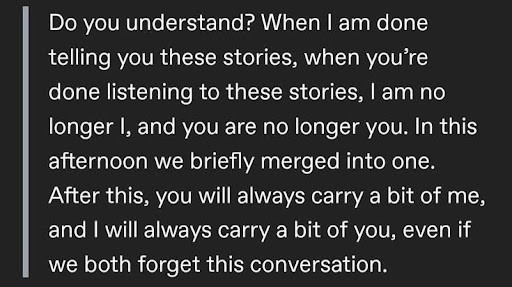





on the value of storytelling;
Into the Water - Paula Hawkins // The Nutritionist - Andrea Gibson // LIFE Magazine 1963 - James Baldwin // Anti-depressants are so not a big deal - Crazy Ex-Girlfriend // Nobel Prize Acceptance Speech 2017 - Kazuo Ishiguro // Invisible Planets - Hao Jingfang (tr. Ken Liu) // tumblr user @/poseidonsarmoury // Road to Hell (Reprise) - Hadestown // Letters to Milena - Franz Kafka // The Catcher in the Rye - J.D. Salinger // Exandria Unlimited: Calamity - Brennan Lee Mulligan
184 notes
·
View notes
Text
ALRIGHT YALL
I’m here to spread patriotic propaganda, bc fuck this country if it’s not about culture and art.
AND IT IS ABOUT BOTH SO I AM WAVING WHITE AND RED FLAG.
Anyway.
There is this movie, The Peasants (Chłopi) directed by DK Welchman an Hugh Welchman. It is animated drama based on polish Nobel prize winning novel by Władysław Reymont. It tells a story about a cycle of life in polish countryside at the end of XIX century. AND I KNOW IT MAY SOUND BORING BUT—




It was animated to look as if it was painted. Many talented artist worked to make oil paintings that became key moments for animators to put together. This technique is inspired by Józef Chełmoński (polish painter) and some of his works can be seen in this movie as scenes. Below Babie Lato and Bociany.


You may be familiar with this technique of filmmaking from Loving Vincent (2017) which is a story about Vincent van Gogh’s life portrayed in his style of painting.


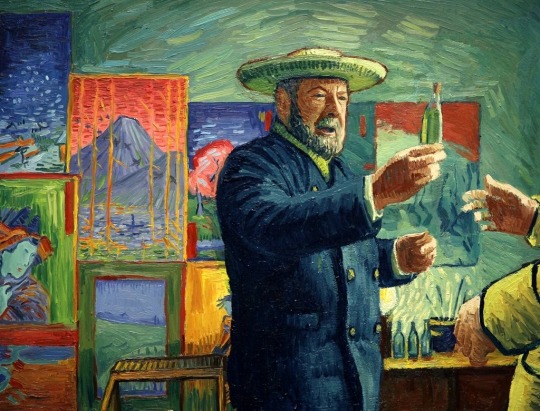
SO WHY AM I DOING THIS? Purely to maybe interest u all in checking out The Peasants.
I’m leaving you links to the trailer, PLEASE I BEG U CHECK IT OUT IT’S SO COOL!!!
youtube
Last thing i am leaving is spotify link to the song from soundtrack.
Thank u and have a great day bye!
#chłopi 2023#the peasants#the peasants movie#władysław reymont#polish movie#animation#be a person of culture watch the peasants#it’s a good book#i beg you to check it out
308 notes
·
View notes
Text
Walcott’s poem appears in @allieesiri ‘s anthology, “A Poem for Every Autumn Day’ (2020). This clip is sourced from her channel, ‘YouTube Poetry with Allie Esiri’, on YouTube. This poem was recited by English actress, Helena Bonham Carter.
Derek Walcott (1930-2017) is thought to be among the greatest of the Caribbean poets, and won a Nobel prize in Literature in 1992.
•
•
•
•
•
•
•
•
•
•
#literature #literaturelover #rumi #helenbonhamcarter
#literaturequotes #classicliterature #poetry
#poetrycommunity #poetrylovers #poetrygram
#book #bookstagram #art #artgallery #nature
#inspiration #inspirational #explore #reading
#explorepage #exploremore #darkacademia #aesthetic
91 notes
·
View notes
Text
20 Simpsons Psychic Predictions That Came True 🚀

Hey there, fellow Simpsons fans! 🎉 If you’ve been following The Simpsons, you know that this iconic show isn’t just about laughs and donuts (though we love those too). It’s also about some eerily accurate predictions that have left us all scratching our heads. 🤔 How did this cartoon get so many things right about the future? Grab a seat, grab a donut 🍩, and let’s dive into some of the wildest psychic predictions from The Simpsons that actually came true! 🚀
🌟🔮✨ Curious about what the future holds for you? Just like The Simpsons predicted some mind-blowing events, you too can uncover what’s in store for your life. Click the link below for your own personal psychic reading and get insights that might just amaze you:
1. Donald Trump’s Presidency 🇺🇸
Season 11, Episode 17 (“Bart to the Future”)
In this episode from the year 2000, Lisa becomes the president and mentions that they inherited quite a budget crunch from President Trump. Fast forward to 2016, and Donald Trump becomes the 45th president of the United States. What the what?! 😲
2. Smartwatches ⌚
Season 6, Episode 19 (“Lisa’s Wedding”)
During a future vision of Lisa’s wedding, her fiancé uses a watch to make a phone call. This was in 1995, way before smartwatches became a thing in the 2010s. Talk about being ahead of the curve! 📱
3. Disney Buys 20th Century Fox 🏰🦊
Season 10, Episode 5 (“When You Dish Upon a Star”)
In 1998, there’s a scene showing the 20th Century Fox sign with a subtitle “A Division of Walt Disney Co.” In 2019, Disney actually bought 21st Century Fox. Coincidence? I think not! 🎬
4. Video Chatting 💻
Season 6, Episode 19 (“Lisa’s Wedding”)
Again in Lisa’s Wedding, we see video calls being made. This was years before Skype, FaceTime, or Zoom became part of our daily lives. The Simpsons were definitely on to something here! 🖥️
5. The Shard in London 🏙️
Season 6, Episode 19 (“Lisa’s Wedding”)
In the same episode (wow, it’s like a crystal ball!), we see a skyline that includes a skyscraper eerily similar to The Shard, which wasn’t built until 2012. 👀
6. Lady Gaga’s Super Bowl Performance 🎤
Season 23, Episode 22 (“Lisa Goes Gaga”)
In 2012, The Simpsons showed Lady Gaga performing at a concert, suspended in the air. Fast forward to 2017, and Gaga did exactly that at the Super Bowl halftime show. Fly, Gaga, fly! 🎇
7. Nobel Prize Winner 🏅
Season 22, Episode 1 (“Elementary School Musical”)
Milhouse predicted that Bengt Holmström would win the Nobel Prize in Economics. And guess what? Holmström did win it in 2016. Way to go, Milhouse! 📊
8. Ebola Outbreak 🌍
Season 9, Episode 3 (“Lisa’s Sax”)
In this 1997 episode, Marge suggests that Bart read a book titled “Curious George and the Ebola Virus.” Years later, in 2014, there was a significant Ebola outbreak. Chills! 😬
9. Siegfried and Roy Tiger Attack 🐅
Season 5, Episode 10 (“$pringfield (Or, How I Learned to Stop Worrying and Love Legalized Gambling)”)
The show depicted a white tiger attacking entertainers similar to Siegfried and Roy. Tragically, in 2003, Roy was indeed attacked by one of their white tigers during a performance. 😥
10. U.S. Wins Olympic Gold in Curling 🥌
Season 21, Episode 12 (“Boy Meets Curl”)
Homer and Marge compete in curling and win a gold medal. In real life, the U.S. men’s team won the gold medal in curling at the 2018 Winter Olympics. Sweep that, skeptics! 🥇
But wait, there’s more! Let’s keep this prediction train rolling with some honorable mentions that didn’t make the top 10 but are still pretty mind-blowing. 🚂💨
11. Horse Meat Scandal 🐴
Season 5, Episode 19 (“Sweet Seymour Skinner’s Baadasssss Song”)
Lunchlady Doris used “assorted horse parts” in the cafeteria food. In 2013, a scandal erupted in Europe when horse meat was found in various beef products.
12. FIFA Corruption Scandal ⚽
Season 25, Episode 16 (“You Don’t Have to Live Like a Referee”)
The episode features a storyline involving corruption in the World Football Federation. In 2015, several FIFA officials were arrested amid a corruption investigation.
13. Farmville 🚜
Season 9, Episode 12 (“Bart Carny”)
In this 1998 episode, kids are seen excitedly playing a yard work simulator game. Fast forward to the 2000s, and Farmville became a massive hit on Facebook.
14. Faulty Voting Machines 🗳️
Season 20, Episode 4 (“Treehouse of Horror XIX”)
Homer tries to vote for Obama in the 2008 election, but the machine keeps changing his vote to McCain. In 2012, there were real reports of voting machines changing votes.
15. Beats by Dre 🎧
Season 8, Episode 14 (“The Itchy & Scratchy & Poochie Show”)
In a scene from 1997, we see a character wearing what looks like modern-day Beats by Dre headphones, years before they existed.
16. Mutant Tomatoes 🍅
Season 11, Episode 5 (“E-I-E-I-(Annoyed Grunt)”)
Homer grows mutant tomatoes after using nuclear power on his crops. In real life, scientists created genetically modified tomatoes that glow in the dark.
17. NSA Surveillance 🕵️
The Simpsons Movie (2007)
The movie depicted the NSA spying on citizens. In 2013, Edward Snowden revealed that the NSA was indeed conducting mass surveillance on American citizens.
18. Shard Building in London 🏙️
Season 6, Episode 19 (“Lisa’s Wedding”)
We see a tall building in the London skyline that resembles The Shard, which was completed in 2012.
19. Michelangelo’s David Censorship 🗿
Season 2, Episode 9 (“Itchy & Scratchy & Marge”)
The episode shows Springfieldians protesting against Michelangelo’s David being exhibited. In 2016, Russian campaigners did try to cover the statue.
20. Autocorrect Fail 📱
Season 6, Episode 8 (“Lisa on Ice”)
Dolph writes a memo that says “Beat up Martin” which gets autocorrected to “Eat up Martha.” Apple’s iPhone autocorrect has had many such hilarious fails.
It’s wild, right? How does a cartoon get so many things right? Well, it’s probably a mix of clever writing, sharp observation, and maybe a bit of that Springfield magic. ✨
And it's not just us hardcore fans who are intrigued. Thanks to the internet, more and more people are discovering the spooky accuracy of The Simpsons' predictions. Social media platforms are buzzing with theories and speculations. Reddit threads are filled with fans dissecting episodes, and YouTube is packed with videos analyzing every prediction. It's like a virtual treasure hunt where every frame might hold a secret clue to our future! 🔮
Some folks even believe that the writers have a time machine or some sort of psychic ability. While that’s probably a stretch, it’s fun to think about! One thing’s for sure – The Simpsons will keep surprising us with their uncanny knack for predicting the future.
Whether you’re a longtime fan or just curious about the show’s “psychic” tendencies, it’s clear that The Simpsons is more than just a TV show. It’s a pop culture phenomenon that continues to influence and amuse us, while also making us think twice about what might come next. So, next time you’re watching, pay close attention – you might just be getting a sneak peek into the future! 🕵️♂️✨
Stay curious, my friends! And remember, the truth is out there… or maybe just in the next episode of The Simpsons. 🌟🚀
#divination#psychic#tarot reading#free readings#pick a card#pick a pile#free tarot#daily tarot#tarot community#tarotblr#tarot cards#tarot#future spouse#astrology#spirituality#crystals#witchcraft#meditation#manifestation#witchblr#spiritualawakening#mysticism#numerology#occult#wicca#tarot deck#the simpsons
36 notes
·
View notes
Text
"But in the end, stories are about one person saying to another: This is the way it feels to me. Can you understand what I’m saying? Does it feel this way to you?" Kazuo Ishiguro, in his Nobel prize (2017) acceptance
14 notes
·
View notes
Text

Meet the unsung contributor to revolutionary breakthroughs in treating polio, cancer, HPV, and even COVID-19: Henrietta Lacks. Born in 1920 Roanoke, Virginia, Henrietta's mother Eliza died when she was only four, and she was ultimately raised by her maternal grandfather in Clover, Virginia. Henrietta worked as a tobacco farmer and attended a segregated school until the age of 14, when she gave birth to a son, Lawrence. A daughter, Elsie, was born three years later --to compound the family's difficulties, Elsie had cerebral palsy and epilepsy. Henrietta and her now-husband David Lacks moved to Turner Station (now Dundalk), Maryland where David had landed a job with a nearby steel plant. At the time Turner Station was one of the oldest African-American communities in Baltimore County and there was sufficient community support for the family to buy a house and produce three more children.
In 1951 at the age of 31, Henrietta died at Johns Hopkins Hospital of cervical cancer, mere months after the birth of the family's youngest son. But before her death --and without her or her family's consent-- during a biopsy two tumour cell samples were taken from Henrietta's cervix and sent to Johns Hopkins researchers. Hernietta's cells carried a unique trait: an ability to rapidly multiply, producing a new generation every 24 hours; a breakthrough that no other human cell had achieved. Prior to this discovery, only cells that had been transformed by viruses or genetic mutations carried such a characteristic. With the prospect of now being able to work with what amounted to the first-ever naturally-occurring immortal human cells, researchers created a patent on the HeLa cell line but hid the donor's true identity under a fake name: Helen Lane.
It is no exaggeration to state that in the 70 years since her death, Henrietta's cells have been bought, sold, packaged, and shipped by thousands of laboratories; with her cells being used as a baseline in as many as 74,000 different studies (including some Nobel Prize winners). Her cells have even been sent into space to study the effects of microgravity, and were instrumental in the Human Genome Project. While no actual law (or even a code of ethics) necessarily required doctors to ask permission before taking tissue from a terminal patient, there was a very clear Maryland state law on the books that forbade tissue removal from the dead without permission, throwing the situation into something of a legal grey area. However because Henrietta was poor, minimally educated, and Black, this standard was quietly (and easily) circumvented and she was never recognized for her monumental contributions to science and medicine ...and her family was never compensated. The family remained unaware of Henrietta's contribution until 1975, when the HeLa line's provenance finally became public. Henrietta had been buried in an unmarked grave in the family cemetery in Clover, Virginia but in 2010 a new headstone was donated and dedicated, acknowledging her phenomenal contribution. That same year the John Hopkins Institute for Clinical and Translational Research established a new Henrietta Lacks Memorial lecture series. A statue of Lacks was commissioned in 2022, to be erected in Lacks's birthplace of Roanoke, Virginia --pointedly replacing a previous statue of Confederate Gen. Robert E. Lee, which had been removed following nationwide protests over the murder of George Floyd.
Dive into The Immortal Life of Henrietta Lacks by Rebecca Skloot, originally published in 2011 and subsequently adapted into an HBO movie in 2017, starring Oprah Winfrey as Henrietta's daughter Deborah and Renee Elise Goldberry as Henrietta. (And yes, this book has been challenged and banned in more than one school district.)
#black lives matter#henrietta lacks#johns hopkins#cell biology#hela#stem cell#translational research#genomics#teachtruth#dothework
62 notes
·
View notes
Text

“The Long Road to a Juneteenth Museum” by James Rusell, from the January/February 2024 issue of Texas Observer Magazine:
(Museum renderings courtesy BIG)
When Fort Worth activist Opal Lee was invited in 2021 to stand alongside President Joe Biden as he signed the bill making Juneteenth a federal holiday, “I could’ve done a holy dance,” the 97-year-old told the Texas Observer recently. “But the kids said they didn’t want me twerking.”
Dancing—and twerking—aside, Lee is clearly used to ambitious projects. She’s often referred to as the grandmother of Juneteenth, mostly because of her 1,400-mile walk, Fort Worth to Washington, D.C., September 2016 to January 2017, seeking recognition for the day that has come to represent freedom for American Blacks. Although the Emancipation Proclamation took effect in 1863, slaves couldn’t be freed where the countryside was still under Confederate control. That ended in Texas on June 19, 1865, when Union troops arrived in Galveston and brought the news.
The latest project of Lee and her allies, to create a museum in Fort Worth honoring Juneteenth, is turning out to be equally ambitious. What began as a modest collection in a small house in the neighborhood where Lee grew up has become a key part of an effort to revitalize Fort Worth’s Historic Southside neighborhood. The most recent and much grander incarnation of the museum is due to open in 2025.
Along the way, the honors paid to Lee—a Nobel Peace Prize nomination, a painting of Lee for the National Portrait Gallery, and the Emmy Award-winning documentary Opal’s Walk for Freedom (2022)—have helped bring attention to that neighborhood, just as they did to the Juneteenth campaign. But tragedy and poverty have held hands there for a long time, and revitalization efforts sometimes find tough sledding.
Lee’s roots run deep into the soil of the Southside and into personal memories of another June 19. On that day in 1939, a mob of racists—about 500 people, according to the Fort Worth Star-Telegram—raided the house there that Lee, her parents, and two brothers, had recently moved into. The family promptly moved out.

A portrait of Opal Lee from the National Portrait Gallery (Courtesy of Talley Dunn Gallery)
The raid was traumatic. Lee told the Star-Telegram in 2003 that afterward her family was “homeless and then living in houses so ramshackle they were impossible to keep clean.” The experience led her to become first an advocate for affordable housing and later an activist regarding homelessness, hunger, and Juneteenth.
Eighty years after the raid, another violent incident a few blocks away would inspire a new generation of Southside activists.
Lee, a retired elementary school teacher and counselor in the Fort Worth school district, also spearheaded the rebuilding of the Metroplex Food Bank (now the Community Food Bank), founded the urban Opal’s Farm, and served on numerous local boards, including the Tarrant Black Historical and Genealogical Society.
Through all that time, she worked to draw attention to Juneteenth. “She was always teaching about Juneteenth” in middle school, said Sedrick Huckaby, the Fort Worth artist who painted Lee for the National Portrait Gallery. “She was always teaching about our heritage and about taking pride in who you are.” Allies like the late Rev. Dr. Ron Myers, a Mississippi doctor and minister, lobbied legislatures across the country and in 1997 helped pass a congressional joint resolution recognizing the holiday. Lee worked on building local support.
In 2014, on the 150th anniversary of Juneteenth, she asked friends and family to donate to a celebration of that, in lieu of buying presents on her birthday. A story in Fort Worth Weekly called her “part grandma, part General Patton” in leading the effort. Two years later, she was putting on her walking shoes for her own personal march on Washington. “If a lady in tennis shoes walked to Washington, D.C, maybe people would pay attention,” she said in her deep, raspy voice, recalling her motivations for the trek. It took another four years after her walk, but the national holiday happened.
Juneteenth has been celebrated by Black Americans for more than 100 years, including in Fort Worth. Texas was the first to designate it a state holiday, in 1980. Since 2020, 26 states, propelled by the murders of Black citizens George Floyd and Breonna Taylor at the hands of police, have followed Texas’ lead, according to the Pew Research Center.
In Fort Worth, Lee and volunteer Don Williams had been working for years to gather artifacts related to local Black history and Juneteenth, including paintings by local Black artist Manet Harrison Fowler, scrapbooks chronicling local Juneteenth celebrations, and memorabilia from the locally filmed movie Miss Juneteenth. Lee inherited a house from her late husband Dale, a retired school district principal, and turned it into the first version of the Juneteenth museum. It housed the growing collection and hosted multiple Juneteenth events and, at one point, computer classes.
While the collection grew, the building, run by volunteers, was deteriorating. Like most public places, it closed in 2020 as COVID-19 spread. After the pandemic, it did not reopen, and the collection was moved out. Then early on the morning of January 11, 2023, it caught on fire. The remains were demolished to make way for the new museum.
Around 2019, Lee, granddaughter Dione Sims, and former Fort Worth Chamber of Commerce executive Jarred Howard had started talking about the possibility of a new Juneteenth Museum. They began buying land around the site of the old house. Howard long had a vision to help his old stomping grounds and wanted to both commemorate the holiday and spur economic development. Well acquainted with developers and architects from his Chamber days, he solicited requests for proposals for a building that could meet those goals. First, local architect Paul Dennehy designed a five-story building with a gallery, event space, and residences. In early 2020 it was pitched to neighborhood association leaders. Too tall, they said, and out of step with the neighborhood. In 2021, local architects Bennett Partners produced a plan for a playful mixed-use campus, estimated to cost about $30 million to build.
In 2022, a new plan, bigger in scope than Lee could have imagined two decades ago, was unveiled. The current proposal is for a 5-acre complex housing a National Juneteenth Museum, with a theater, restaurant, art galleries, and a “business incubator” space to spur Southside entrepreneurship, designed by the internationally renowned architecture firm Bjarke Ingels Group (BIG). The price tag is an estimated $70 million. So far, the nonprofit National Juneteenth Museum, formed in 2020, has raised about $30 million of that, mostly from major donors and foundations, Lee said.
Douglass Alligood, a partner at BIG and the chief architect of the currently planned museum, got an earful during his field work on the project, including from Lee’s friends and supporters. In multiple visits, he met with Lee as well as neighborhood leaders. The conclusion: The museum had to represent the community and not be divorced from it.
“We were inspired by the neighborhood typology—the homes that feature historic gabled silhouettes and protruding porches, also known in context as a ‘shotgun’ house,” he said. “Neighborhood groups and community members found that, together, the BIG and KAI Enterprises [the local architecture firm] design teams demonstrate a deep understanding of the Juneteenth story and commitment to work with the local community to celebrate the holiday’s history and local culture of the Historic Southside.”
Eleven rectangular glass-clad building segments, with peaks and valleys of varying heights, will create a star-shaped courtyard in the middle. “The ‘new star,’ the nova star represents a new chapter for the African-Americans looking ahead towards a more just future,” Alligood said.
Fine, locals said, but what people there really need is a grocery store.

It was a cold morning in early October, and Patrice Jones needed help unloading herbs. She was in the courtyard of Connex, a new three-story business and retail complex about two blocks from the planned site of the museum. Jones and a group of volunteers, mostly in their 20s and 30s, from Southside Community Gardens, are planting their 79th and 80th backyard vegetable gardens in the neighborhood, she said proudly. It’s pick-up day for those who’ve already established gardens.
The initiative is part of the larger By Any Means 104 effort, named for the 76104 zip code, and co-founded by Jones in 2020. The group’s focus on local issues includes addressing the lack of fresh food in the area instead of waiting for a grocery store. Jones, a feisty advocate and former claims adjuster, has run it full time since 2021. If the city can’t get them a grocery store, she said, they’ll teach residents to grow their own food.
The Juneteenth Museum is important, Jones said, between handing out herbs and greeting volunteers. But in her circles, she said, people also ask, “Can we get a health clinic? Can we get a pharmacy?” And of course, “Can we get a grocery store?”
According to a 2018 University of Texas Southwestern Medical Center report, the 76104 zip code has the lowest life expectancy rate in Texas and a high maternal mortality rate. It’s also a victim of what Jones calls “food apartheid,” a term she prefers to “food desert,” an indicator of an area with little access to fresh foods. Desert implies it’s natural; apartheid, she said, is an intentional act. She blames city government and its white-dominated culture.
But hunger is not a sufficient reason for a grocery chain to decide where to open a store, even if it could be part of a historical complex.
Grocery store owners “use different metrics,” including population density, said Stacy Marshall, president of Southeast Fort Worth, Inc., an economic development group. “We can’t yet make a compelling case.” The area needs more housing, he said. “Build density—rooftops—and grocery stores come.”
Marshall is a force in bringing new development to the southeast part of the city, a large historically and ethnically diverse area that includes the Historic Southside.
Since he took the job a decade ago, “development has gone gangbusters,” he said. But development has also brought gentrification: “It’s so expensive to purchase dirt here and get a single-family home,” he said. One Dallas real estate firm put together a $70 million deal for a mixed-use development in the area, but it has stalled.
The Juneteenth museum site is within the Evans-Rosedale urban village, a city designation focused on bringing investment to the area. It’s seeing an uptick in interest from developers, but nowhere near what’s been promised by local officials.
“There have been attempts in the past. There’s the Evans Avenue Plaza, but most people don’t know about it,” said Bob Ray Sanders, communications director for the Fort Worth Black Chamber of Commerce. The plaza, also part of the Evans-Rosedale village, is meant to be a community gathering space and includes a new library. About a mile away is the Hazel Harvey Peace Center for Neighborhoods, which houses numerous city offices.
Many of the neighborhood’s nagging problems date to the mid-20th century, when integration meant, ironically, the loss of many black-owned businesses, while highway construction—as it did in many American cities—cut off Fort Worth’s Black community from downtown and wealthier neighborhoods. “By doing that, people on the Westside [turned] a blind eye to people on the Eastside,” Sanders said.
Housing construction seems to be picking up, mostly on an infill basis. But while developers are buying homes, Marshall said, they are mostly sitting on them and waiting until they can get higher prices.
Longtime assistant city manager Fernando Costa said development work in historic urban districts presents more challenges than creating new neighborhoods from pastureland. Beyond the physical complications of older infrastructure, historic preservation concerns and, often, environmental problems left over from earlier development, Costa said, such projects “require getting existing neighborhood involvement.”
There’s also the issue of crime. According to the Fort Worth Police Department, nearly 560 crimes were reported in the 76104 zip code between mid-May and late November 2023. Assault, larceny, drug and alcohol violations, and vehicle break-ins made up more than three-quarters of the reports. That’s compared to 165 in the same time period in the mostly-white, wealthy 76109 zip code in West Fort Worth.
In the early morning of October 12, 2019, white police officer Aaron Dean, responding to a welfare check at the house, killed 28-year Black woman Atatiana Jefferson, who was playing video games with her nephew. Dean was later found guilty of manslaughter and sentenced to 11 years in prison.
Jefferson’s murder lit a fire under a younger generation of activists who aren’t waiting for change, such as Jones, who also worked to get police accountability in response to the murder, and Angela Mack, whose doctoral thesis is about Jefferson and the neighborhood.
“I’m a good, ol’ fashioned Funkytown Black nerd,” said Mack, an instructor in the comparative race and ethnic studies department at Texas Christian University, where she received her doctorate in English rhetoric.
After Jefferson’s murder, Mack changed her thesis topic to address that tragedy. She saw that, between her mother and the national media, two different stories were being told.
“When we’re thinking about the Southside, we think about Fairmount and the Medical District in terms of revitalization. But when you cross the highway, you’re in an area with crime and poverty,” she said, drinking a latte at Black Coffee, one of the few coffee shops in the area. “When people [look] at the community, people are looking at what’s not here. It’s a deficit model of communication instead of seeing the good that’s here.
“I’m not anti-development,” she said, but economic development shouldn’t be the museum’s purpose.
“When you’re building something, it should not be [a question of] how many people we employ, but how does it help define the Southside? The development will come. I’m concerned about who controls the narrative,” she said. “The main focus should be how does this speak about our history and heritage.”
Jones also worries that history will be lost. She’s afraid that rising property values will push out poor people.
Sims has heard those concerns before. Property taxes go up with any new development, she said. And everyone’s going to complain, even if they want change.
When the museum opens in 2025, Lee just wants to make sure she’s there to see it.
“I’m looking forward to it,” she said. She’d be 99. “I hope I’m still here.”
#black history#Black History Month#Texas#texas history#fort worth#north texas#juneteenth#museum#museums
35 notes
·
View notes
Text
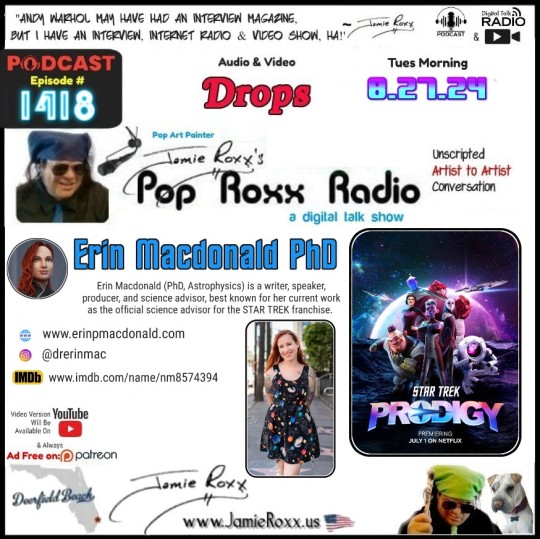
youtube
🎬 Watch The Television Show Trailer in the comments below:
Tuesday, Aug 27, 2024.
Episode #1418 of 🎨#JamieRoxx’s www.PopRoxxRadio.com 🎙️#TalkShow and 🎧#Podcast w/ Featured Guest:
#ErinMacdonald (#PhD, #Astrophysics)
is a #writer, #speaker, #producer, and #scienceadvisor,
best known for her current work as the official science advisor for the #STARTREK franchise.
Also Voice Actor on
#StarTrekProdigy and the video game #StarTrekOnline.
Pop Art Painter Jamie #Roxx (www.JamieRoxx.us) welcomes Erin Macdonald (PhD, Astrophysics) is a writer, speaker, producer, and science advisor, voice Actress to the Show!
(Click to go there)
● WEB: www.erinpmacdonald.com
● IG: @drerinmac ( www.instagram.com/drerinmac )
● IMDB: www.imdb.com/name/nm8574394
Erin Macdonald (PhD, Astrophysics) is a writer, speaker, producer, and science advisor, best known for her current work as the official science advisor for the STAR TREK franchise. She has also voiced her fictional counterpart in the Star Trek universe: Lt Cmdr Dr Erin Macdonald in Star Trek: Prodigy and the video game Star Trek Online. Known as “The Julia Child of Science,” as a science communicator Erin has appeared on NPR's Science Friday and Short Wave podcasts, provided commentary for numerous docuseries, and wrote and hosted the award-winning "Science of Star Trek" promotional videos for Paramount+. She wrote the baby board book "Star Trek: My First Book of Space" and wrote and narrated the Audible Original "The Science of Sci-Fi" in collaboration with The Great Courses.Prior to all of this work, she received her PhD at 25 at the University of Glasgow in Scotland and conducted research with the Laser Interferometer Gravitational-wave Observatory (LIGO) Scientific Collaboration, but left shortly before their 2017 Nobel Prize-winning discovery of gravitational waves. She also has worked as a museum educator, community college professor, and Department of Defense systems engineering technical advisor. She received dual BA’s from the University of Colorado at Boulder in Physics with Astrophysics (cum laude ) and Mathematics. Through her company Spacetime Productions, she produces award-winning sci-fi films by LGBTQIA+ creators. Her most recent film IDENTITEAZE written and directed by Jessie Earl is available for streaming at go.nebula.tv/identiteaze.
● Media Inquiries:
Annie Jeeves
Publicist
Cinematic Red PR
cinematicred.com
7 notes
·
View notes
Text
The Ig Nobel Prize, for scientific research that makes people laugh and then makes them think. This year's winners!
CHEMISTRY and GEOLOGY PRIZE [POLAND, UK]
Jan Zalasiewicz, for explaining why many scientists like to lick rocks.
REFERENCE: “Eating Fossils,” Jan Zalasiewicz, The Paleontological Association Newsletter, no. 96, November 2017. Eating fossils | The Palaeontological Association (palass.org)
WHO TOOK PART IN THE CEREMONY: Jan Zalasiewicz
LITERATURE PRIZE [FRANCE, UK, MALAYSIA, FINLAND]
Chris Moulin, Nicole Bell, Merita Turunen, Arina Baharin, and Akira O’Connor for studying the sensations people feel when they repeat a single word many, many, many, many, many, many, many times.
REFERENCE: “The The The The Induction of Jamais Vu in the Laboratory: Word Alienation and Semantic Satiation,” Chris J. A. Moulin, Nicole Bell, Merita Turunen, Arina Baharin, and Akira R. O’Connor, Memory, vol. 29, no. 7, 2021, pp. 933-942. doi.org/10.1080/09658211.2020.1727519
WHO TOOK PART IN THE CEREMONY: Chris Moulin, Akira O’Connor
MECHANICAL ENGINEERING PRIZE [INDIA, CHINA, MALAYSIA, USA]
Te Faye Yap, Zhen Liu, Anoop Rajappan, Trevor Shimokusu, and Daniel Preston, for re-animating dead spiders to use as mechanical gripping tools.
REFERENCE: “Necrobotics: Biotic Materials as Ready-to-Use Actuators,” Te Faye Yap, Zhen Liu, Anoop Rajappan, Trevor J. Shimokusu, and Daniel J. Preston, Advanced Science, vol. 9, no. 29, 2022, article 2201174. doi.org/10.1002/advs.202201174
WHO TOOK PART IN THE CEREMONY: Te Faye Yap and Daniel Preston
PUBLIC HEALTH PRIZE [SOUTH KOREA, USA] Seung-min Park, for inventing the Stanford Toilet, a device that uses a variety of technologies — including a urinalysis dipstick test strip, a computer vision system for defecation analysis, an anal-print sensor paired with an identification camera, and a telecommunications link — to monitor and quickly analyze the substances that humans excrete.
REFERENCE: “A Mountable Toilet System for Personalized Health Monitoring via the Analysis of Excreta,” Seung-min Park, Daeyoun D. Won, Brian J. Lee, Diego Escobedo, Andre Esteva, Amin Aalipour, T. Jessie Ge, et al., Nature Biomedical Engineering, vol. 4, no. 6, 2020, pp. 624-635. doi.org/10.1038/s41551-020-0534-9
REFERENCE: “Digital Biomarkers in Human Excreta,” Seung-min Park, T. Jessie Ge, Daeyoun D. Won, Jong Kyun Lee, and Joseph C. Liao, Nature Reviews Gastroenterology and Hepatology, vol. 18, no. 8, 2021, pp. 521-522. doi.org/10.1038/s41575-021-00462-0
REFERENCE: “Smart Toilets for Monitoring COVID-19 Surges: Passive Diagnostics and Public Health,” T. Jessie Ge, Carmel T. Chan, Brian J. Lee, Joseph C. Liao, and Seung-min Park, NPJ Digital Medicine, vol. 5, no. 1, 2022, article 39. doi.org/10.1038/s41746-022-00582-0
REFERENCE: “Passive Monitoring by Smart Toilets for Precision Health,” T. Jessie Ge, Vasiliki Nataly Rahimzadeh, Kevin Mintz, Walter G. Park, Nicole Martinez-Martin, Joseph C. Liao, and Seung-min Park, Science Translational Medicine, vol. 15, no. 681, 2023, article eabk3489. doi.org/10.1126/scitranslmed.abk3489
WHO TOOK PART IN THE CEREMONY: Seung-min Park
COMMUNICATION PRIZE [ARGENTINA, SPAIN, COLOMBIA, CHILE, CHINA, USA]
María José Torres-Prioris, Diana López-Barroso, Estela Càmara, Sol Fittipaldi, Lucas Sedeño, Agustín Ibáñez, Marcelo Berthier, and Adolfo García, for studying the mental activities of people who are expert at speaking backward.
REFERENCE: “Neurocognitive Signatures of Phonemic Sequencing in Expert Backward Speakers,” María José Torres-Prioris, Diana López-Barroso, Estela Càmara, Sol Fittipaldi, Lucas Sedeño, Agustín Ibáñez, Marcelo L. Berthier, and Adolfo M. García, Scientific Reports, vol. 10, no. 10621, 2020. doi.org/10.1038/s41598-020-67551-z
WHO TOOK PART IN THE CEREMONY: María José Torres-Prioris, Adolfo García
MEDICINE PRIZE [USA, CANADA, MACEDONIA, IRAN, VIETNAM]
Christine Pham, Bobak Hedayati, Kiana Hashemi, Ella Csuka, Tiana Mamaghani, Margit Juhasz, Jamie Wikenheiser, and Natasha Mesinkovska, for using cadavers to explore whether there is an equal number of hairs in each of a person’s two nostrils.
REFERENCE: “The Quantification and Measurement of Nasal Hairs in a Cadaveric Population,” Christine Pham, Bobak Hedayati, Kiana Hashemi, Ella Csuka, Margit Juhasz, and Natasha Atanaskova Mesinkovska, Journal of The American Academy of Dermatology, vol. 83, no. 6, 2020, pp. AB202-AB202. doi.org/10.1016/j.jaad.2020.06.902
WHO TOOK PART IN THE CEREMONY: Christine Pham, Natasha Mesinkovska, Margit Juhasz, Kiana Hashemi, Tiana Mamaghani
NUTRITION PRIZE [JAPAN]
Homei Miyashita and Hiromi Nakamura, for experiments to determine how electrified chopsticks and drinking straws can change the taste of food.
REFERENCE: “Augmented Gustation Using Electricity,” Hiromi Nakamura and Homei Miyashita, Proceedings of the 2nd Augmented Human International Conference, March 2011, article 34. doi.org/10.1145/1959826.1959860
WHO TOOK PART IN THE CEREMONY: Homei Miyashita, Hiromi Nakamura
EDUCATION PRIZE [CHINA, CANADA, UK, THE NETHERLANDS, IRELAND, USA, JAPAN]
Katy Tam, Cyanea Poon, Victoria Hui, Wijnand van Tilburg, Christy Wong, Vivian Kwong, Gigi Yuen, and Christian Chan, for methodically studying the boredom of teachers and students.
REFERENCE: “Boredom Begets Boredom: An Experience Sampling Study on the Impact of Teacher Boredom on Student Boredom and Motivation,” Katy Y.Y. Tam, Cyanea Y. S. Poon, Victoria K.Y. Hui, Christy Y. F. Wong, Vivian W.Y. Kwong, Gigi W.C. Yuen, Christian S. Chan, British Journal of Educational Psychology, vol. 90, no. S1, June 2020, pp. 124-137. doi.org/10.1111/bjep.12549
REFERENCE: “Whatever Will Bore, Will Bore: The Mere Anticipation of Boredom Exacerbates its Occurrence in Lectures,” Katy Y.Y. Tam, Wijnand A.P. Van Tilburg, Christian S. Chan, British Journal of Educational Psychology, epub 2022. doi.org/10.1111/bjep.12549
WHO TOOK PART IN THE CEREMONY: Christian Chan, Katy Y.Y. Tam, Wijnand A.P. Van Tilburg
PSYCHOLOGY PRIZE [USA]
Stanley Milgram, Leonard Bickman, and Lawrence Berkowitz for experiments on a city street to see how many passersby stop to look upward when they see strangers looking upward
REFERENCE: “Note on the Drawing Power of Crowds of Different Size,” Stanley Milgram, Leonard Bickman, and Lawrence Berkowitz, Journal of Personality and Social Psychology, vol. 13, no. 2, 1969, pp. 79-82. psycnet.apa.org/doi/10.1037/h0028070
WHO TOOK PART IN THE CEREMONY: Len Bickman
PHYSICS PRIZE [SPAIN, GALICIA, SWITZERLAND, FRANCE, UK]
Bieito Fernández Castro, Marian Peña, Enrique Nogueira, Miguel Gilcoto, Esperanza Broullón, Antonio Comesaña, Damien Bouffard, Alberto C. Naveira Garabato, and Beatriz Mouriño-Carballido, for measuring the extent to which ocean-water mixing is affected by the sexual activity of anchovies.
REFERENCE: “Intense Upper Ocean Mixing Due to Large Aggregations of Spawning Fish,” Bieito Fernández Castro, Marian Peña, Enrique Nogueira, Miguel Gilcoto, Esperanza Broullón, Antonio Comesaña, Damien Bouffard, Alberto C. Naveira Garabato, and Beatriz Mouriño-Carballido, Nature Geoscience, vol. 15, 2022, pp. 287–292. doi.org/10.1038/s41561-022-00916-3
WHO TOOK PART IN THE CEREMONY: Bieito Fernandez Castro, Beatriz Mouriño-Carballido, Alberto Naveira Garabato, Esperanza Broullon, Miguel Gil Coto
27 notes
·
View notes
Text
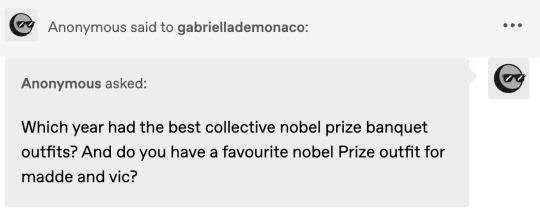
this anon: I don't know why but I can't seem to publish my reply to your message, so I'll write it here instead:
---------------------------------
Collectively, that's a difficult question since we have 4 ladies in SRF now (I'm assuming you don't want to me go back to the years when there were only 3) and it's HARD for them to be good at the same time, and I refuse to name a year without Madeleine.
2014: Sofia's mesh/sequin/see-through dress was a big no no for me; not a fan of the others either except Victoria
2016: Love the other dresses but Sofia's green atrocity ruined it.
2017: Both Madeleine & Sofia looked very nice, but I hated Victoria's fluffy high neck.
2019: the year of Vic'a B&W horror
So I guess, 2015? Madeleine was splendid, Victoria was pregnant and had a flowy purple gown, Silvia in her usual red queenly dress, and I don't hate Sofia's black dress either.
Favourite nobel prize outfit for Victoria: maybe the red one in 2014?

The purple one in 2023 was good as well.
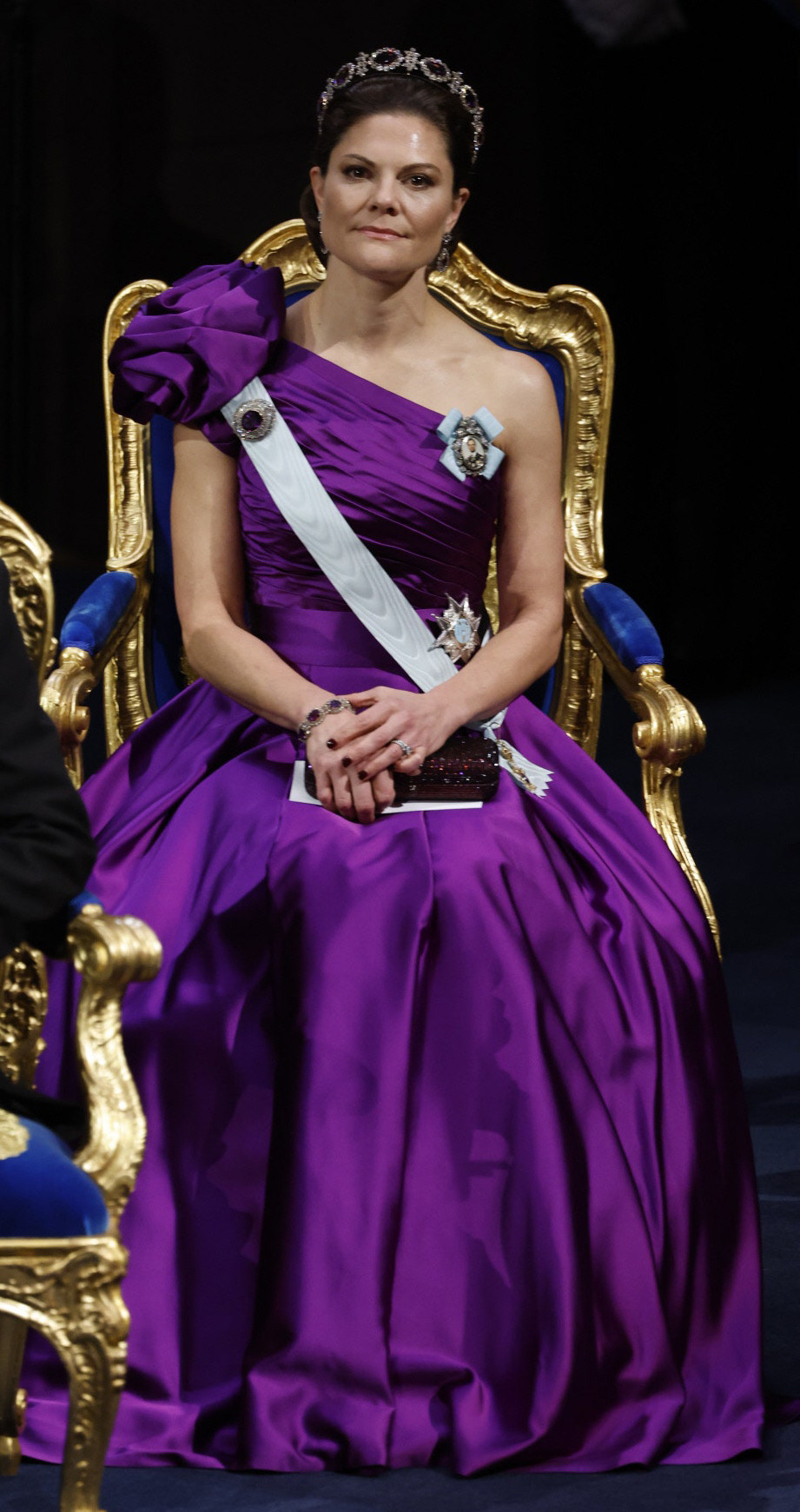
She also had some great ones in her earlier years but less flashy.
Madeleine: definitely the blue/grey one in 2015. Together with the aquamarine kokoshnik tiara it's a dream come true.

The pink one in 2016 was also nice, but the top section was just too loose for me. The skirt was heaven.

Another honourable mention would be the strapless grey dress in 2012:

9 notes
·
View notes
Text
“As far back as 1992, the Union of Concerned Scientists warned that humanity faced a stark choice between spending its resources on war and violence, or on preventing catastrophic environmental damage. The report was signed by 1,700 scientists, including the majority of Nobel Prize winners in the sciences.17 In 2017 the warning was reissued, and this time it was signed by more than 15,000 scientists: it concluded that the state of the world was even worse than before. The first UCS report attracted a good deal of attention; the second one passed almost unnoticed.”
― Amitav Ghosh, The Nutmeg's Curse: Parables for a Planet in Crisis
18 notes
·
View notes
Text

Suzu Hirose is cast in movie “A Pale View of Hills.” The film is based on 1982 novel “A Pale View of Hills” by Kazuo Ishiguro, who won the Nobel Prize in 2017 and wrote the original novel that was made into the 1993 British film “The Remains of the Day.” Kei Ishikawa (“A Man“) will direct the movie and also handle the screenplay adaptation. Filming for the movie has already commenced.
“A Pale View of Hills” will be released sometime during summer, 2025 in Japan.
In the 1980’s, Niki lives in London. She has a Japanese mother, Etsuko (Suzu Hirose), but her English father passed away. After dropping out of a university, Niki pursues her dream of becoming a writer. To write her own book, she visits her mother Etsuko. Niki has rare visited Etsuko’s home since the death of Niki’s older half-sister. Etsuko lives alone in the suburbs of London. She experienced the atomic bombing in Nagasaki, Japan and came to England, but Niki doesn’t know anything about her mother’s past.
After the death of her husband and her daughter from her first marriage, Etsuko has lived alone in her home that is filled with memories. After spending a few days with Niki, Etsuko begins to talk about a strange dream which she has been having recently. Her dream is about a woman and her young daughter that Etsuko met when she was living in Nagasaki, Japan in the 1950’s.
#suzu hirose#hirose suzu#広瀬すず#a pale view of hills#jfilm#j-film#japanese film#jactress#j-actress#japanese actress
2 notes
·
View notes
Text
The great Zen teacher Thich Nhat Hanh has written beautifully about why learning to love others begins with learning to love ourselves — a sentiment that the reactive modern cynic might dismiss as the vacant fodder of self-help books, but one which more considered reflection reveals to be deeply truthful and deeply uncomfortable. What, after all, does loving oneself even mean — particularly if we’re aspiring to be unselfish and generous, and to outgrow the illusory ego-shell we call a self?
That’s what Caribbean poet and playwright Derek Walcott (January 23, 1930–March 17, 2017) — a writer of such extraordinary poetic prowess that his 1992 Nobel Prize in Literature appears a wholly inadequate measure of his mastery and mesmerism — addresses with a luminous sidewise gleam in a poem titled “Love After Love,” found in his "Collected Poems: 1948–1984."
LOVE AFTER LOVE
by Derek Walcott
The time will come
when, with elation,
you will greet yourself arriving
at your own door, in your own mirror,
and each will smile at the other’s welcome,
and say, sit here. Eat.
You will love again the stranger who was your self.
Give wine. Give bread. Give back your heart
to itself, to the stranger who has loved you
all your life, whom you ignored
for another, who knows you by heart.
Take down the love letters from the bookshelf,
the photographs, the desperate notes,
peel your own image from the mirror.
Sit. Feast on your life.
***
22 notes
·
View notes
Text
it feels kind of euphoric because there was an actual real risk of having a majority of front national representatives in our national assembly that would also have lead to a far right government it's not the case and the projections so far give the left coalition in first place but still. there's way too many votes for this fascist party. they were ~10 in 2017 there's at least 10 times more now. we lived through the most dirty campaign ever. we had the government spread lies and fake news using fake websites created by their own party to make people believe that the left would give people smaller retirement pensions. people have called the left antisemit for being anti zionist and supporting palestine. we've had the most vile shit being said about our candidates while the far right has criminal who have raped kids and held people hostages. there's actual nazis in there, some with published pics of them in nazi hats and shirts. and yet the left was the one being shat on for weeks. there's so much work to do, we need to re politicise the younge regenerations, share our ideas and program. the economic program was validated by a number of economist including a nobel prize winner. a better france is possible and it's hard not to lose hope but tonight i have a little hope and that's nice
6 notes
·
View notes
Text
"But in the end, stories are about one person saying to another: This is the way it feels to me. Can you understand what I’m saying? Does it feel this way to you?" Kazuo Ishiguro, in his Nobel prize (2017) acceptance speech
13 notes
·
View notes